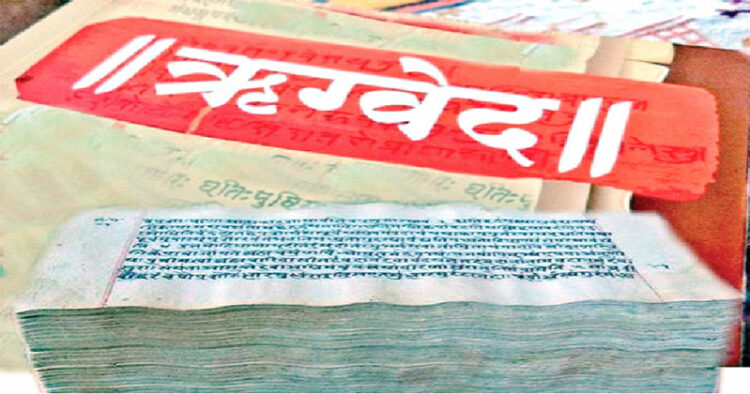Various fundamental meanings of the word Arya have been reviewed in the previous article. Before moving on to the next topic, let’s look at two more similar words that European researchers have declared as ‘genetic or genealogical. They are ‘Dasyu’ (monster or devil) and ‘Daas’ (slaves.)
One can come across various meanings of these words in Sanskrit lexicon as well. The word Dasyu has been interpreted to mean (1) brave robber / thief, (2) villain / evil, (3) demonic, (4) enemy, etc. It is quite obvious that these meanings are also related to ‘attributes’ or ‘deeds/actions’ and none of it is genetic or genealogical. The same goes for the word daas. This also means (1) employee, (2) servant, (3) Shudra, (4) envoy / messenger, etc. They are either attributive or description of deed, certainly not genealogical. Let us now look at some examples of the terms Arya and Dasyu in the Vedic literature.
Vedic References
The Rigveda is considered to be the oldest text in the Sanskrit literature. The words Arya and Dasyu are rarely found in it. Let’s look at one or two of them for example here:
(Rig Veda 1.51.8.)
Meaning: “Hey Indra, you identify the Aryas and the monsters among us. Thou shalt tame and punish those who have strayed from thy vows. O Indra, it is our wish that you grow mightier and bless the host (of yajna) the right inspiration”. The mantra offers a prayer to Indra. It appears to have two expressions, Arya and Dasyu. Let us also look at the meaning given by our commentators. According to the meaning given by the ancient commentator of Rigveda, Sayanacharya (14th century AD), meaning “Hey Indra, there are scholar (yagna) performers, you know them, and those Dasyu are their enemies who harass those Aryas”. Here Sayanacharya interpreted the word Arya to mean ‘learned sacrificers’ and the word Dasyu to mean ‘troublesome enemy’. By what means do these two words appear ‘genetic’ or ‘genealogical’?
Swami Dayanand Saraswati (19th century AD), another commentator on the Rig Veda, says in the commentary on the same mantra,’ Meaning- “Arya means a person of religious disposition, a scholar, a benefactor to all and Dasyu is a person who causes trouble to others, a fool, an ungodly person, an evil person.”. Here too, in what sense do you find these two words ‘genetic’ or ‘genealogical’?
In another place in the Rig Veda
Rig Veda 6.24.8.
Sayanacharya interpreted the word Arya to mean ‘learned sacrificers’ and the word Dasyu to mean ‘troublesome enemy’. By what means do these two words appear ‘genetic’ or ‘genealogical’?
In the first line of this mantra, the word Dasyujutay is used. Commenting on this, Sayanacharya also explains the meaning of the word Dasyu as karmavarjit which means someone who has abandoned his duties – loafer / dawdler! Sayanacharya explains, “No matter how much the Dasyu coaxes the host to praise Lord Indra, Lord Indra does not reciprocate / respond”
Whether it is Sayanacharya or Dayanand Saraswati, both these commentators say that Aryadoes not mean ‘aggressive aliens who migrated to India from Central Asia in the early 1800’s BC’ and does not refer to Dasyu as ‘indigenous people living in India before the Aryan invasion’. For thousands of years, until the 19th century, these words were attributive or indicators of virtues or vices. The million dollar question is: How did they suddenly become ‘genetic’ and ‘communal’ from the second half of the 19th century?
Strayedrationale
We saw in the previous article how the various meanings of the word Arya are given in our Sanskrit lexicon. But the description of Arya as ‘fair’ (white?), ‘tall’, ‘well built’, ‘green eyed’, and ‘Roman nosed’ by scholars like Sir William Jones and Max Muller doesn’t refer to any traceable reference. The exact answer to where the meaning may have derived from is not found in the treatises and texts of the Western scholars. But, as stated in the very first article, a misguided assumption seems to have been made by Mortimer Wheeler. That assumption is – from the descriptions of Indra, the Aryandeity in the Rig Veda, and the ruined cities of Harappa, Mohenjodaro, etc., found in excavations in the Indus Valley; it seems that they were blown up by Indra himself. So it indicates the assumption that all such descriptions of Indra and other deities in the Rig Veda must be of the ‘Aryan lineage’. Since then these researchers started (mis)matching the descriptions of ‘Aryans’ to the descriptions of various deities. Let us look at a mantra in the Rig Veda as an example:
Rig Veda 1.19.5.
This includes praising prayer addressed to the fire and god of war (maruta) while invocating the Fire god bySage MedhatithiKanva. The meaning of this mantra is, “O fire, come along here with the god of war who are of fair complexion, strongly built, excellentKshatriyas (warriors) and those devour enemies (proficient / aggressive in warfare).” Since the Maruta deity referred here is the Arya deity, the researchers assumed that Aryan could fit the same description! There are still many such mantras in the Rig Veda which describe the physical attributes of various deities. In this way, the assumptions made by the European scholars from numerous Vedic mantras seem to have gone astray and subsequently the research done by Indian scholars based on those assumptions would obviously have been just as erratic.
Also Read: Aryan Invasion Theory: Understanding Myths
It is evident that the attempts of these Western scholars only conveniently mislead as far as the meanings of the words Arya, Dasyuare concerned. It seems an attempt to forcefully bring irrelevant threads together and prove the strayed views as a theory. The attempts are nothing but ‘flights of fancy’ without an ounce of truth.




















Comments